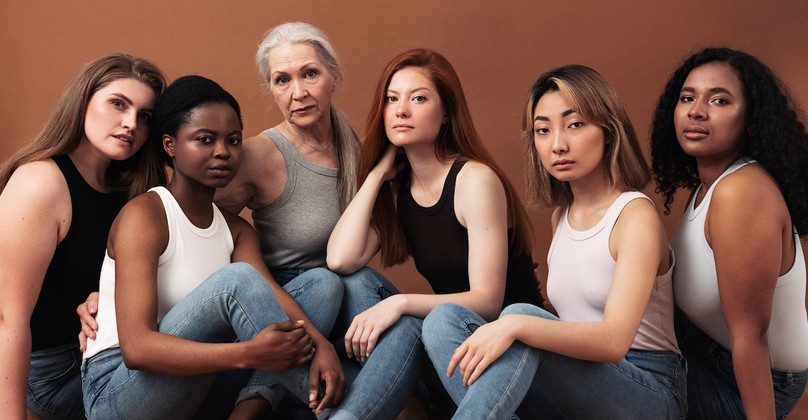
More Than a Feeling: How and Why God Created Female Identity
“Mom? Dad? I need to tell you I’m not really a girl.” When 12-year-old Grace came out as non-binary to her parents, they were shocked and shaken. Despite her theologically sound Christian background, her view of gender had shifted within a matter of months after her peers influenced her perspective at an after-school club. She had adopted the feelings of so many girls her age: She believed she was a boy trapped in a girl’s body.
Grace’s story is increasingly common among teenagers and young adults. Some 80% of the LGBTQ community comes from a Christian or religious background. And they receive no small affirmation from medical care providers, cultural influencers, social media, educators, and peers. From nearly every direction of their lives, young women receive affirmation that they not only feel like they were born in the wrong body but were born in the wrong body.
Today’s young women are asking significant questions about their identities, relationships, and futures with little more than their emotions to guide them. Their biological sex is considered irrelevant to their true, authentic selves. No wonder Generation Z suffers from epidemic levels of mental health struggles.
But God’s self-revelation - through His creation and Word - are unchanging sources of certainty and truth.
Biology Is Bigger Than You Think

Consider creation: The differences between males and females start well before external influences can shape our self-perception. Beginning at the 8th week in utero, a male baby experiences a surge of testosterone which “masculinizes” his developing brain. Centers that control motion and aggression increase, while centers that control language and empathy decrease. Females are wired for empathy and connection.
At less than a day old, female babies are more responsive to the cries of other babies. Male infants prefer to look at things that are in motion, while female infants prefer to look at the faces of their caregivers. Female babies can interpret facial expressions and vocal tones to a greater degree than male babies. By the time she is 18 months old, a female toddler can tell whether someone is really listening to her by “reading” these non-verbal cues. Behavioral differences between males and females begin long before society relates to them according to a specific gender.
As children grow, these biologically based differences express themselves in gender-specific behavior. Just think of how boys and girls use their imaginations. Little boys play by imagining conflict – “good guys and bad guys,” superheroes and their nemeses. Little girls play by imagining relationships – house, tea party, school. And this isn’t only true of human children: even young female rhesus monkeys prefer playing with and caring for baby dolls. There are strong neurological differences between the average male and female.
The differences continue as children grow, especially surrounding friendships and communications. Among boys, hierarchy, and structure organize their camaraderie. Among girls, hierarchy destroys female friendships. Boys develop friendships around a shared interest or activity. Girls develop friendships around verbal communication and shared emotions. In fact, little girls - and grown women - experience a biological comfort from stress in talking about their feelings and verbally connecting with other women. That teen girl you can’t tear away from texting her friends might be alleviating stress through communication. They are neurologically wired to talk!
We haven’t even begun to talk about other biological differences between male and female hormones, reproductive organs, and muscular tissues, all structured around the possibility of generating (male) or gestating (female) new life. Males and females are designed to fulfill this potential down to the muscle fibers. Males have more fast-twitch muscle fibers, allowing them to exert greater bursts of energy and strength than females, who have more slow-twitch muscle fibers. Practically, that means a woman’s muscle probably can’t pull a car by a rope, but she can sustain unrelenting contractions for 18 hours without quitting.
These and many other facts demonstrate two truths about gender: First, our biology reveals our gender as a man or a woman. Despite how a girl may perceive herself, she is comprehensively female. She may not feel at ease being a girl. Or relate to attitudes and activities that are more characteristically masculine. Or wish she had been born a boy. But down to the 23rd chromosome of her DNA, she is still a girl.
Second, our biology informs our gender as a man or a woman. From the earliest days after birth to the tumultuous days of puberty, our biology drives our behavior. This doesn’t mean we’re just a clump of cells and organs. Instead, it means we’re complex whole beings created in God’s image, both spiritual and physical beings.
Back to the Beginning

The opening chapters of Genesis confirm what God has revealed in creation. In Genesis 1, humans are created male and female – two equal image-bearing people given charge over the earth. I’m Genesis 2, human beings relate to each other as man and woman - complex persons who understand themselves by encountering the similarities and differences between each other. To be a male (Gen 1) is to be a man (Gen 2). To be a female (Gen 1) is to be a woman (Gen 2).
Our bodies are good because God created the physical world and calls it good. Not only is the body good, but it is also a guide. Our physical bodies tell us who we are. While biological sex and gender identity are distinct aspects of our identities, they are not divisible.
Modern science is still discovering what the Bible told us all along: God’s very good design for humanity as His image-bearers includes being embodied as male or female, man or woman; it’s part of how we reflect and connect with our Creator. The differences between males and females are both obviously simple and irreducibly complex. And our gender identity is so much more than changing emotions or cultural stereotypes. It is a gift of God who made us to reflect and connect with Himself.
We can’t understand what it means to be a woman until we grasp what it means to be an image bearer of God. And until we are reconciled to God in Christ, we will never find reconciliation within ourselves or our relationships. Our culture tells us that gender is an expression of ourselves. Scripture tells us that our gender is an expression of our Creator.
How You and I Can Respond

A young woman with gender incongruity deserves our compassion and patience. She has been influenced by a culture that tells her the path to spiritual and emotional renewal is found through physical and hormonal harm. And, overwhelmingly, she is searching for peace; an untold number of young women look to a transgender identity to find significance and belonging or as a coping mechanism for other sources of pain.
In Jesus’s time, being sick or disabled came with stigma and shame. You may have been forbidden from entering the temple, which conveyed the ceremonial purity God required of His people to approach Him. In many cases, you’d be prevented from working, marrying, or having a family, which was essential for social relationships and economic security in an ancient, agrarian society. You were an outsider, marginalized, cut off from the community. This was devastating in an honor/shame culture like the Bible’s.
Jesus dropped everything when He met people with these kinds of needs. He broke religious traditions and drew the ire of the social elite in order to help them. To be physically healed meant more than recovery from a condition. It meant being restored to a community. Those whom Jesus restored didn’t remain marginalized. They were brought from isolation to connection, from alienation to acceptance.
The affliction of gender confusion or dysphoria may not be outwardly visible. But overwhelmingly, the women and girls who suffer from it feel every bit as alienated—not only from others but also from themselves. Were Jesus walking among us today, I can’t help but wonder how He would respond to the lonely little girl who feels like she doesn’t fit or to the broken woman trying to heal herself of a soul-deep wound.
He would be as He always has been—infinitely kind, tender-hearted, patient, understanding, and deeply moved by her pain. And, He would love her enough to tell her the truth in a spirit of gentleness and grace.
We are His ambassadors, His messengers entrusted with good news: they don’t have to settle for their brokenness. He offers them wholeness. He gave His own body to recover and restore those who feel alienated from their own bodies. Better still, He brings them into the Body of Christ.
Data and portions of this article are from Katie J. McCoy’s To Be a Woman: The Confusion Over Female Identity and How Christians Can Respond (B&H Publishing, 2023)
In her groundbreaking new book, To Be a Woman: The Confusion Over Female Identity and How Christians Can Respond, author and women’s ministry director, Katie J. McCoy, Ph.D. addresses a topic that is everywhere in the news – gender identity. We are living in a cultural moment where the definition of “woman” eludes the keenest of thinkers and brightest of scientists. In To Be a Woman, McCoy covers every angle, from social, philosophical, relational, biological, to theological, utilizing her extensive research, powerful illustrations, and solid Biblical truths to shed light on the views of gender in today’s society. To Be a Woman will quickly become a trusted resource for anyone who seeks to understand this complex topic.
“A generation of young women and girls have been swept away by the current of gender ideology, and we are only beginning to see its effects. Behind the headlines, social media campaigns, and political agendas are vulnerable, confused, and often hurting adolescents searching for what it means to be a woman. Only when we confront dominant cultural beliefs with the whole-person vision for humanity in God’s image can we hope to turn the tide." says McCoy.
Photo credit: ©GettyImages/Youngoldman
Katie J. McCoy holds a Ph.D. in Systematic Theology and is a former seminary professor. McCoy teaches and writes on the intersection of theology, culture, and women's issues and has co-authored a work on the doctrine of humanity as part of the Theology for the People of God series (B&H Academic). Included among her research is discovering the pattern of justice for women in Old Testament laws. You can find Katie online at blondeorthodoxy.com.








